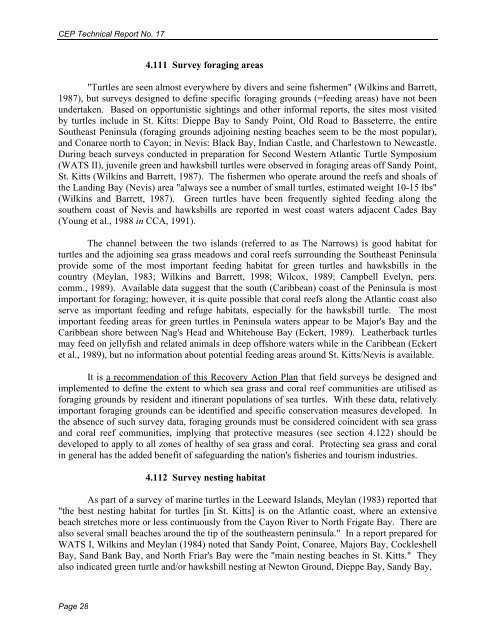Sea Turtle Recovery Action Plan for St. Kitts and Nevis - WIDECAST
Sea Turtle Recovery Action Plan for St. Kitts and Nevis - WIDECAST
Sea Turtle Recovery Action Plan for St. Kitts and Nevis - WIDECAST
Create successful ePaper yourself
Turn your PDF publications into a flip-book with our unique Google optimized e-Paper software.
CEP Technical Report No. 17<br />
4.111 Survey <strong>for</strong>aging areas<br />
"<strong>Turtle</strong>s are seen almost everywhere by divers <strong>and</strong> seine fishermen" (Wilkins <strong>and</strong> Barrett,<br />
1987), but surveys designed to define specific <strong>for</strong>aging grounds (=feeding areas) have not been<br />
undertaken. Based on opportunistic sightings <strong>and</strong> other in<strong>for</strong>mal reports, the sites most visited<br />
by turtles include in <strong>St</strong>. <strong>Kitts</strong>: Dieppe Bay to S<strong>and</strong>y Point, Old Road to Basseterre, the entire<br />
Southeast Peninsula (<strong>for</strong>aging grounds adjoining nesting beaches seem to be the most popular),<br />
<strong>and</strong> Conaree north to Cayon; in <strong>Nevis</strong>: Black Bay, Indian Castle, <strong>and</strong> Charlestown to Newcastle.<br />
During beach surveys conducted in preparation <strong>for</strong> Second Western Atlantic <strong>Turtle</strong> Symposium<br />
(WATS II), juvenile green <strong>and</strong> hawksbill turtles were observed in <strong>for</strong>aging areas off S<strong>and</strong>y Point,<br />
<strong>St</strong>. <strong>Kitts</strong> (Wilkins <strong>and</strong> Barrett, 1987). The fishermen who operate around the reefs <strong>and</strong> shoals of<br />
the L<strong>and</strong>ing Bay (<strong>Nevis</strong>) area "always see a number of small turtles, estimated weight 10-15 lbs"<br />
(Wilkins <strong>and</strong> Barrett, 1987). Green turtles have been frequently sighted feeding along the<br />
southern coast of <strong>Nevis</strong> <strong>and</strong> hawksbills are reported in west coast waters adjacent Cades Bay<br />
(Young et al., 1988 in CCA, 1991).<br />
The channel between the two isl<strong>and</strong>s (referred to as The Narrows) is good habitat <strong>for</strong><br />
turtles <strong>and</strong> the adjoining sea grass meadows <strong>and</strong> coral reefs surrounding the Southeast Peninsula<br />
provide some of the most important feeding habitat <strong>for</strong> green turtles <strong>and</strong> hawksbills in the<br />
country (Meylan, 1983; Wilkins <strong>and</strong> Barrett, 1998; Wilcox, 1989; Campbell Evelyn, pers.<br />
comm., 1989). Available data suggest that the south (Caribbean) coast of the Peninsula is most<br />
important <strong>for</strong> <strong>for</strong>aging; however, it is quite possible that coral reefs along the Atlantic coast also<br />
serve as important feeding <strong>and</strong> refuge habitats, especially <strong>for</strong> the hawksbill turtle. The most<br />
important feeding areas <strong>for</strong> green turtles in Peninsula waters appear to be Major's Bay <strong>and</strong> the<br />
Caribbean shore between Nag's Head <strong>and</strong> Whitehouse Bay (Eckert, 1989). Leatherback turtles<br />
may feed on jellyfish <strong>and</strong> related animals in deep offshore waters while in the Caribbean (Eckert<br />
et al., 1989), but no in<strong>for</strong>mation about potential feeding areas around <strong>St</strong>. <strong>Kitts</strong>/<strong>Nevis</strong> is available.<br />
It is a recommendation of this <strong>Recovery</strong> <strong>Action</strong> <strong>Plan</strong> that field surveys be designed <strong>and</strong><br />
implemented to define the extent to which sea grass <strong>and</strong> coral reef communities are utilised as<br />
<strong>for</strong>aging grounds by resident <strong>and</strong> itinerant populations of sea turtles. With these data, relatively<br />
important <strong>for</strong>aging grounds can be identified <strong>and</strong> specific conservation measures developed. In<br />
the absence of such survey data, <strong>for</strong>aging grounds must be considered coincident with sea grass<br />
<strong>and</strong> coral reef communities, implying that protective measures (see section 4.122) should be<br />
developed to apply to all zones of healthy of sea grass <strong>and</strong> coral. Protecting sea grass <strong>and</strong> coral<br />
in general has the added benefit of safeguarding the nation's fisheries <strong>and</strong> tourism industries.<br />
4.112 Survey nesting habitat<br />
As part of a survey of marine turtles in the Leeward Isl<strong>and</strong>s, Meylan (1983) reported that<br />
"the best nesting habitat <strong>for</strong> turtles [in <strong>St</strong>. <strong>Kitts</strong>] is on the Atlantic coast, where an extensive<br />
beach stretches more or less continuously from the Cayon River to North Frigate Bay. There are<br />
also several small beaches around the tip of the southeastern peninsula." In a report prepared <strong>for</strong><br />
WATS I, Wilkins <strong>and</strong> Meylan (1984) noted that S<strong>and</strong>y Point, Conaree, Majors Bay, Cockleshell<br />
Bay, S<strong>and</strong> Bank Bay, <strong>and</strong> North Friar's Bay were the "main nesting beaches in <strong>St</strong>. <strong>Kitts</strong>." They<br />
also indicated green turtle <strong>and</strong>/or hawksbill nesting at Newton Ground, Dieppe Bay, S<strong>and</strong>y Bay,<br />
Page 28
















